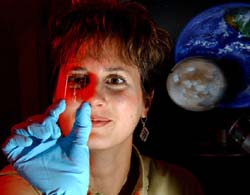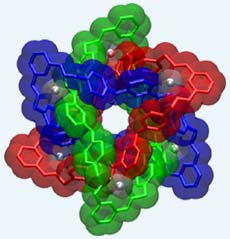
With a microscope and computer monitor, researchers at NASA’s Marshall Space Flight Center in Huntsville, Ala., watch fluorescent bacteria flow through tiny, fluid highways on a dime-sized lab on a chip.
Lab-on-a-chip technology allows chemical and biological processes — previously conducted on large pieces of laboratory equipment — to be performed on a small glass plate with fluid channels, known to scientists as microfluidic capillaries.
“We are studying how lab-on-a-chip
Animated characters on the Internet are often soulless. They stare, speak monotonously and have limited facial expression. More realistic characters are being tested by a European team of researchers. Could such enhanced characters benefit e-commerce and build better Web-based communities?
Most of us interact with our computers by punching keys. But the time is ripe for a more sophisticated and realistic interface. One way forward is to program characters known as avatars. They can be given
USC researchers provide unique view of inherited disorders, cancer with discussion of new field of epigenetics in journal Nature
Researchers from the USC/Norris Comprehensive Cancer Center are heralding an entirely new approach to the treatment of aging, inherited diseases and cancer in a review paper published in today’s issue of the journal Nature. Dispelling the belief that the only way to treat such conditions is by fixing or replacing damaged genes, they are instead focusing
Researchers from Newcastle University in the UK have ended a 15-year search for the gene that causes the rare Cornelia de Lange Syndrome. (CdLS).
CdLS affects just one in 40,000 live births but can be devastating, with affected youngsters having growth problems, missing or deformed limbs, gastro-intestinal disorders, seizures, cardiac problems, neurological, learning and behavioural difficulties and oro-dental issues.
Doctors in the USA and Europe knew that there was likely to be a rogue

UCLA chemists have devised an elegant solution to an intricate problem at the nanoscale that stumped scientists for many years: They have made a mechanically interlocked compound whose molecules have the topology of the beloved interlocked Borromean rings. In the May 28 issue of the journal Science, the team reports nanoscience that could be described as art.
The UCLA group is the first to achieve this goal in total chemical synthesis, which research groups worldwide have been pursuing.
Scientists have identified what may be a completely new way in which bacteria defend themselves against their hosts. The bacteria have stolen a key defensive gene from the very animals that they are invading – and are now using it against them. This research from the European Molecular Biology Laboratory (EMBL) is featured in today’s issue of the open access journal Genome Biology.
EMBL Team Leader Toby Gibson points out that such a discovery has clear medical implications. “This study give